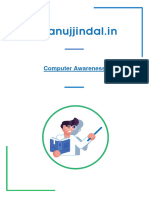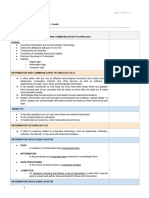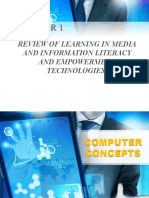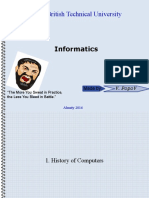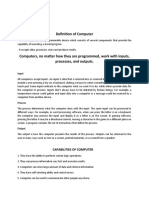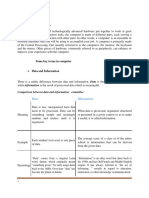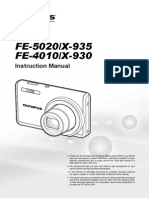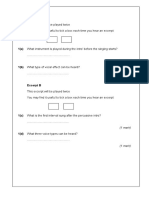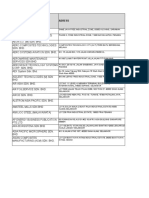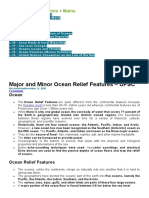Introduction to Information
and Communication
Technology
1
�Rules & Regulations
• Get to class on time
• Attend every class
• Turn cellular phones off
• Come to class prepared
• Pay full attention during lecture and don’t disturb others
• Actively participate in class activities
2
�Subject Division
• 4 Quizzes (Surprised-10%)
• 4 Assignments (Submit before due date – 10%)
• Midterm –30%
• Terminal Exam (30%)
• Lab tasks (20%)
3
�A World of Computer
• Computers are everywhere.
4
� What is Technology?
• Practical application of science is technology.
• Technology is a human innovation in action that involves the
generation of knowledge and processes to develop systems
that solve problems.
5
�Information Technology
• Information technology refers to both the hardware and
software that are used to store, retrieve, and manipulate
information.
• The practice of creating and/or studying computer systems and
applications.
6
� Data
• Data are collection of raw facts or figures.
• Raw means that the facts have not been processed to get their
exact meaning.
• Data is given to the computer for processing.
• Data may consist of numbers, character, symbols or pictures etc.
• Example: Students fill an admission form when they get
admission in college.
7
�Data
• The form consists of raw facts about the students.
• These raw facts are student’s name, father name, address etc.
• The purpose of collecting this data is to maintain the record of
the students during their study period of time.
8
�Information
• Data is used as input for the processing and information is the
output of this processing.
• Information is an organized and processed form of data.
• More meaningful than data.
• Used for making decisions.
• Example
Number of Products Sold in November in All Sales Areas
Product South North East West
AB34652 22025 46723 45890 98345
9
�Information
• Example of information:
• In colleges and universities, the raw facts about students are
stored on admission forms.
• If we want to find out a list of all students who live in
Abbottabad.
• We will apply some processing on this data.
• The processing will give us the desired list.
• This list is form of processed data and will be called
information.
10
�Introduction to Computer
• Computer is derived from Latin word “compute” that means to
calculate .
• It represent decimal number through a string of binary digits.
• The word “computer” usually refers to the CPU plus internal
memory .
• It works on numeric and non-numeric data.
• Charles Babbage is called the "Father" of the computer.
11
�What is a Computer?
• Computers is an electronic device that
➢ Operates under the control of instructions (software)
➢ Accepts data (input)
➢ Manipulate data (process)
➢ Generates information (output)
12
�A Computer
System
�What is
Computer?
14
�What Task a Computer Perform?
• Computers can perform four general operations, which comprise the
information processing cycle.
➢ INPUT – entering data into the computer.
➢ PROCESSING – performing operations on the data.
➢ OUTPUT – presenting the results.
➢ STORAGE – saving data, or output for future use.
15
�How is a computer defined?
• Electronic device operating under the control of instructions
stored in its own memory.
Processes data into
Accepts data information
Raw facts, figures,
Data that is organized,
and symbols
meaningful, and useful
Produces and stores results
16
� Input Devices
Central Processing Unit
Primary
Components Memory
of Computer Output Devices
Storage Devices
17
�Input Devices
• Any hardware device that sends data to a computer, allowing user
to interact with and control it.
• Most commonly used or primary input devices on a computer are
the keyboard and mouse
• Examples: scanners, digital cameras, joysticks, and microphones.
18
�Central Processing Unit
• CPU contains electronic circuits that cause processing to occur.
• The CPU interprets instructions to the computer, performs the
logical and arithmetic processing operations.
19
�Central Processing Unit Parts
• Arithmetic Logic Unit (ALU)
• Control Unit
➢ Both contains register or high-speed storage area.
20
�Central Processing Unit Parts
o Arithmetic Logic Unit (ALU)
• Performs arithmetic and logical operations.
o Control Unit
• Translates each instruction and then carries out the instruction.
• Directs electronic signals between memory and ALU and between
memory and input and output devices.
21
�Memory
• A memory is just like a human brain.
• It is used to store data and instructions.
• Computer memory is the storage space in the computer, where data
is to be processed and instructions required for processing are stored.
• The memory is divided into large number of small parts called cells.
• Each location or cell has a unique address, which varies from zero to
memory size minus one.
22
�Output Devices
• Any device that receives data from a computer, usually for
display, projection, or physical reproduction
• This includes data produced at a software level, such as the
result of a calculation, or at a physical level, such as a printed
document.
• Examples: printer, monitor, speakers, headphones, projectors
etc
23
�Storage Devices
• It is not directly accessible by the CPU.
• Computer usually uses its input/output channels to access secondary
storage and transfers the desired data using intermediate area in
primary storage.
24
�When was the first computer invented?
• There is no easy answer to this question due to the many
different classifications of computers.
• The first mechanical computer, created by Charles Babbage in
1822, doesn't really resemble what most would consider a
computer today.
• Therefore, this Lecture provides a listing of each of the computer
firsts, starting with the Difference Engine and leading up to the
computers we use today.
25
�When was the word "computer" was first used?
• The word "computer" was first recorded as being used in 1613 and
originally was used to describe a human who performed calculations
or computations.
• The definition of a computer remained the same until the end of the
19th century, when the industrial revolution gave rise to machines
whose primary purpose was calculating.
26
�ABACUS
• The abacus, also called a counting
frame, is a calculating tool that was in
use in the ancient Near East, Europe,
China, and Russia, centuries before the
adoption of the written Hindu–Arabic
numeral system. The exact origin of the
abacus is still unknown.
27
�Napier's Bones
• It was a manually-operated calculating device
which was invented by John Napier (1550-1617) of
Merchiston.
• In this calculating tool, he used 9 different ivory
strips or bones marked with numbers to multiply
and divide. So, the tool became known as
"Napier's Bones. It was also the first machine to
use the decimal point.
28
�Pascaline
• Pascaline is also known as Arithmetic Machine or
Adding Machine. It was invented between 1642
and 1644 by a French mathematician-philosopher
Biaise Pascal. It is believed that it was the first
mechanical and automatic calculator.
29
�Stepped Reckoner or Leibnitz wheel
• It was developed by a German mathematician-
philosopher Gottfried Wilhelm Leibnitz in 1673. He
improved Pascal's invention to develop this
machine. It was a digital mechanical calculator
which was called the stepped reckoner as instead
of gears it was made of fluted drums.
30
�Difference Engine
• In the early 1820s, it was designed by Charles
Babbage who is known as "Father of Modern
Computer".
• It was a mechanical computer which could
perform simple calculations. It was a steam driven
calculating machine designed to solve tables of
numbers like logarithm tables.
31
�Tabulating Machine
• It was invented in 1890, by Herman Hollerith, an
American statistician. It was a mechanical
tabulator based on punch cards.
• It could tabulate statistics and record or sort data
or information
32
�Differential Analyzer
• It was the first electronic computer introduced in
the United States in 1930. It was an analog device
invented by Vannevar Bush. This machine has
vacuum tubes to switch electrical signals to
perform calculations. It could do 25 calculations in
few minutes.
33
�Mark I
• The next major changes in the history of computer
began in 1937 when Howard Aiken planned to
develop a machine that could perform calculations
involving large numbers. In 1944, Mark I computer
was built as a partnership between IBM and
Harvard. It was the first programmable digital
computer.
34
�Generation of Computers
• Generation in computer talk is a step-in technology.
• The term generation was used to distinguish b/w various
hardware and software technologies that together make up a
computer.
• The are totally five generations knows till today.
• Each generation is defined by a significant technological
development that changes fundamentally how computers
operate.
➢ L eading to more compact, less expensive, but more powerful,
efficient and robust machines.
35
� Generation of Computers
First Generation
• The period 1940 to 1956, roughly considered as the First
Generation of Computer.
• The first-generation computers were developed by using
vacuum tube.
• The input of this system was based on punched cards and paper
tape; however, the output was displayed on printouts.
• The first-generation computers worked on binary-coded concept
(i.e., language of 0-1). Examples: ENIAC, etc.
36
�Generation of Computers
Second Generation
• The period 1956 to 1963 is roughly considered as the period of
Second Generation of Computers .
• The second-generation computers were developed by using
transistor technology .
• In comparison to the first generation, the size of second
generation was smaller.
• In comparison to computers of the first generation, the
computing time taken by the computers of the second
generation was lesser (microseconds).
37
�Generation of Computers
Second Generation
38
�Generation of Computers
Third Generation
• The period 1963 to 1971 is roughly considered as the period of third-
generation of computers.
• The third-generation computers were developed by using the
Integrated Circuit (IC) technology.
• In comparison to second generation computers, the size of computers
of third generation was smaller.
• In comparison to the computers of the second generation, the
computing time taken by the computers of the third generation was
lesser.
39
�Generation of Computers
Third Generation
40
�Generation of Computers
Fourth Generation
• The period 1972 to 2010 is roughly considered as the fourth
generation of computers.
• The fourth-generation computers were developed by using
microprocessor technology.
• By coming to fourth generation, computer became very small in size,
it became portable.
• The machine of fourth generation started generating
very low amount of heat.
• It is much faster and accuracy became more reliable.
• The production cost reduced to very low in comparison
to the previous generation.
• It became available for the common people as well.
41
�Generation of Computers
Fourth Generation
42
�Characteristics of a Computer
• Reliability
➢ Very reliable
➢ The electronic components in modern computer rarely break
or fail.
43
�Characteristics of a Computer
• Accuracy
➢ Accuracy means that computer provide results without any
errors
➢ Computer can process large amount of data and produce
results accurately.
➢ Human Errors are like wrong command, inaccurate data input
etc.
44
�Characteristics of a Computer
• Versatility
➢ Can perform all kind of job simultaneously.
➢ Can do diverse nature of works like calculations, listen to audio,
searching etc. at the same time.
45
�Characteristics of a Computer
• Consistency
➢ Work in consistent way
➢ Free from "Tiredness“
➢ Free from Lack of "Concentration“
➢ All jobs with equal attention
• Flexibility
➢ Can perform all kind of job simultaneously
46
�Characteristics of a Computer
• Communication
• Computers have the capability of
communicating with other computers.
• We can connect two or more computers
by communication device such as modem
• Computers can share data , instruction
and information
• Connected computers are called networks
• Can communicate with other people in
the world using networks like internet
47
�Characteristics of a Computer
• Control Sequence
• Computer works strictly according to the given instructions.
• Follows the same sequence of execution that is given in a
program.
48
�Characteristics of a Computer
• Cost Reduction
• Perform difficult task in less time and less cost
• For example, we may have to hire many people to handle an
office. The same work can be performed by single person with
the help of computer.
• Reduce cost.
49
� Merits of Computer
• Now that we know the characteristics of computers, we can see
the advantages that computers offer−
• Computers can do the same task repetitively with same accuracy.
• Computers do not get tired or bored.
• Computers can take up routine tasks while releasing human
resource for more intelligent functions.
50
�Demerits of Computer
Despite so many advantages, computers have some disadvantages
of their own −
• Computers have no intelligence; they follow the instructions
blindly without considering the outcome.
• Regular electric supply is necessary to make computers work,
which could prove difficult everywhere especially in developing
nations
• Computers have not Recognize better than human.
• Computer never generate innovative idea.
51
�Demerits of Computer
• Lack of Commonsense
• A computer is only a tool. It can not think. It does not have
Intelligence or common sense as well.
• Inability to correct
• A computer can not correct the wrong Instruction itself. This
follows the fact that computer cannot use its brain because it
does not have one
• Dependence on human instructions
• It can only do what it is told to do.
52

